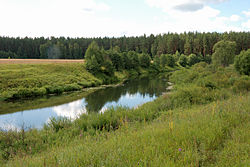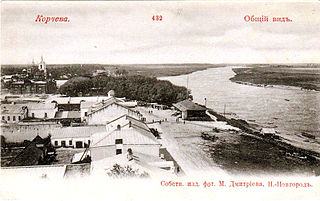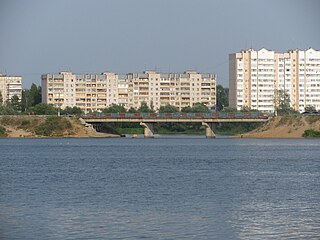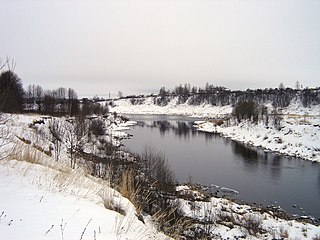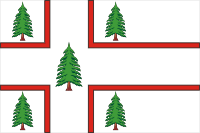| Shosha River | |
|---|---|
Shosha River | |
| Native name | Шоша |
| Country | Russia |
| Physical characteristics | |
| River mouth | Volga River |
| Length | 163 km (101 mi) [1] |
| Basin features | |
| Basin size | 3,080 km2 (1,190 sq mi) [1] |
Shosha River (Russian : Шо́ша) is a river in Zubtsovsky, Staritsky, Kalininsky and in Konakovsky Districts of Tver Oblast and Lotoshinsky District of Moscow Oblast in Russia. It is a right tributary of the Volga River. The length of the Shosha River is 163 kilometres (101 mi). [1] The area of its basin is 3,080 square kilometres (1,190 sq mi). The river flows into the Ivankovo Reservoir. The Shosha freezes up in November through early January and stays icebound until late March or early April.

Russian is an East Slavic language, which is official in the Russian Federation, Belarus, Kazakhstan and Kyrgyzstan, as well as being widely used throughout Eastern Europe, the Baltic states, the Caucasus and Central Asia. It was the de facto language of the Soviet Union until its dissolution on 25 December 1991. Although, nowadays, over two decades after the breakup of the Soviet Union, Russian is used in official capacity or in public life in all the post-Soviet nation-states, as well as in Israel and Mongolia, the rise of state-specific varieties of this language tends to be strongly denied in Russia, in line with the Russian World ideology.

A river is a natural flowing watercourse, usually freshwater, flowing towards an ocean, sea, lake or another river. In some cases a river flows into the ground and becomes dry at the end of its course without reaching another body of water. Small rivers can be referred to using names such as stream, creek, brook, rivulet, and rill. There are no official definitions for the generic term river as applied to geographic features, although in some countries or communities a stream is defined by its size. Many names for small rivers are specific to geographic location; examples are "run" in some parts of the United States, "burn" in Scotland and northeast England, and "beck" in northern England. Sometimes a river is defined as being larger than a creek, but not always: the language is vague.

Zubtsovsky District is an administrative and municipal district (raion), one of the thirty-six in Tver Oblast, Russia. It is located in the south of the oblast and borders with Staritsky District in the north, Lotoshinsky District of Moscow Oblast in the northeast, Shakhovskoy District, also of Moscow Oblast, in the east, Gagarinsky District of Smolensk Oblast in the south, Sychyovsky District, also of Smolensk Oblast, in the southwest, and with Rzhevsky District in the west. The area of the district is 2,166.5 square kilometers (836.5 sq mi). Its administrative center is the town of Zubtsov. Population: 17,216 ; 19,398 (2002 Census); 21,950 (1989 Census). The population of Zubtsov accounts for 40.2% of the district's total population.
The source of the Shosha is in Zubtsovsky District of Tver Oblast, northwest of the selo of Knyazhyi Gory. It flows north, turns northeast, enters Staritsky District and turns north. At the village of Sidorovo the Shosha turns east and crosses two tiny bits of Moscow Oblast, further downstream crossing to Kalininsky District of Tver Oblast. Downstream of the village of Novinki the Shosha enters the Ivankovo Reservoir, where it accepts two of its major tributaries, the Lama (right) and the Inyukha (left). The urban-type settlements of Kozlovo and Novozavidovsky are located at the right bank of the reservoir. The Ivankovo Reservoir is crossed by the dam of the Moscow – Saint Petersburg Railway, and downstream of the dam the Volga enters from the left, at the former location of the mouth of the Shosha before the reservoir was filled in 1937.

Lama River is a river in the Moscow and Tver Oblasts in Russia, a tributary of the Shosha River. The river is 139 kilometres (86 mi) long. The area of its drainage basin is 2,330 square kilometres (900 sq mi). The Lama River freezes up in November and stays under the ice until late March or early April. Historically, the river was a part of the important waterway from the Volga River to the Moskva River. The city of Volokolamsk that has been standing on the Lama River since the 12th century was previously known as Volok Lamsky after the process of a watercraft portage.
Urban-type settlement is an official designation for a semi-urban settlement, used in several Eastern European countries. The term was historically used in Bulgaria, Poland, and the Soviet Union, and remains in use today in 10 of the post-Soviet states.
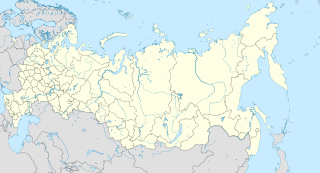
Kozlovo is an urban locality in Konakovsky District of Tver Oblast, Russia, located close the right bank of the Shosha River. Population: 3,884 (2010 Census); 4,388 (2002 Census); 4,368 (1989 Census).
The middle course of the Shosha, upstream of Kozlovo, is located in Zavidovo nature reserve, a closed area which is only accessible to high-level state employees.

Zavidovo is a village (selo) in Konakovsky District of Tver Oblast, Russia. It is used as an official residence place for the President of Russia.
The drainage basin of the Shosha includes the whole Lotoshinsky District, the southwest of Konakovsky and Kalininsky District, the southeast of Staritsky District, the east of Zubtsovsky District, as well as the northern parts of Volokolamsky and Shakhovskoy Districts of Moscow Oblast, and minor areas in Klinsky and Istrinsky Districts, also in Moscow Oblast. The town of Volokolamsk and the urban-type settlements of Shakhovskaya, Lotoshino, Izoplit, Kozlovo, and Novozavidovsky lie in the drainage basin of the Shosha.

Volokolamsky District is an administrative and municipal district (raion), one of the thirty-six in Moscow Oblast, Russia. It is located in the west of the oblast and borders with Mozhaysky District in the south, Shakhovskoy District in the west, Lotoshinsky District in the northwest, Klinsky District in the northeast, and with Istrinsky and Ruzsky Districts in the east. The area of the district is 1,683.51 square kilometers (650.01 sq mi). Its administrative center is the town of Volokolamsk. Population: 53,244 ; 49,032 (2002 Census); 37,863 (1989 Census). The population of Volokolamsk accounts for 44.0% of the district's total population.

Shakhovskoy District is an administrative and municipal district (raion), one of the thirty-six in Moscow Oblast, Russia. It is located in the west of the oblast. The area of the district is 1,218.88 square kilometers (470.61 sq mi). Its administrative center is the urban locality of Shakhovskaya. Population: 25,372 ; 23,061 (2002 Census); 23,783 (1989 Census). The population of Shakhovskaya accounts for 42.3% of the district's total population.

Klinsky District is an administrative and municipal district (raion), one of the thirty-six in Moscow Oblast, Russia. It is located in the northwest of the oblast and borders with Tver Oblast in the north, Lotoshinsky District in the northwest, Volokolamsky District in the west, Istrinsky District in the south, Solnechnogorsky District in the southeast, and with Dmitrovsky District in the east. The area of the district is 2,019.62 square kilometers (779.78 sq mi). Its administrative center is the town of Klin. Population: 127,779 (2010 Census); 127,938 ; 48,658 (1989 Census). The population of Klin accounts for 63.1% of the district's total population.
